TORONTO (July 10) — The best and worst of the Toronto Maple Leafs during the Kyle Dubas era has involved the most–critical position of any hockey club: goaltender. It was a topic bantered about by Bryan Hayes, Dave Feschuk (Toronto Star) and Al’s Brother (who?) on Friday’s edition of TSN–1050 Overdrive while debating a priority for the Maple Leafs — re–signing free agent forward Zach Hyman or obtaining a “reliable” stopper.
Given Jack Campbell’s splendid run this past season (17–3–2 in 22 starts, 2.15 goals–against average, .925 save–percentage), it would appear the Leafs already have such a figure. After missing long stretches (Jan. 24–Feb. 27 / Mar. 1–20) with a nagging groin ailment, Campbell performed superbly down the stretch and into the playoffs, when he compiled a 1.81/.934 split in the seven–game loss to Montreal. But, his injury past cannot be ignored. Included was a five–week absence with Los Angeles (knee) in November/December 2018. And, the Maple Leafs currently do not have a second goalie with NHL experience under contract for next season. So, the TSN–1050 panel, spearheaded by Hayes, agreed that nothing else resonates so emphatically with the Blue and White.
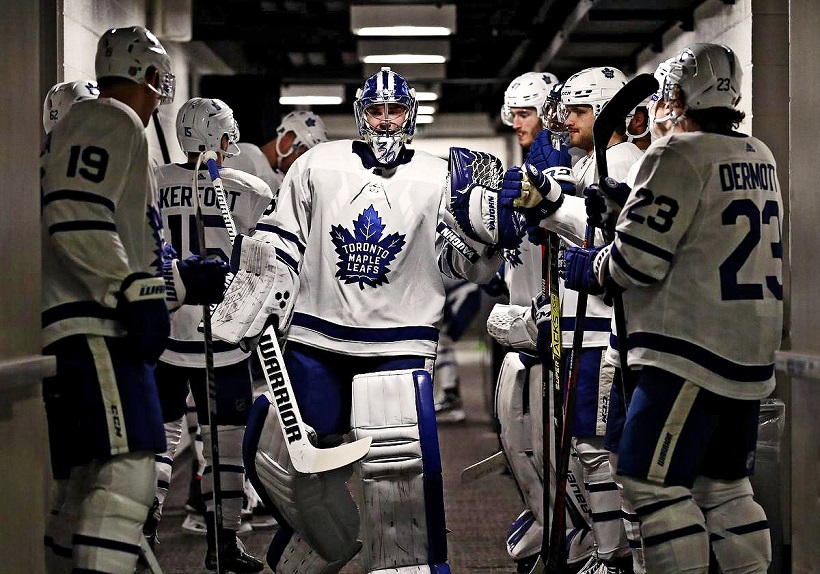
WHO WILL EMERGE FROM THE SHADOWS TO RIDE SHOT–GUN WITH JACK CAMPBELL NEXT SEASON? IT’S THE MOST–IMPORTANT DECISION THE MAPLE LEAFS WILL ENCOUNTER THIS SUMMER. TORONTO STAR PHOTO
Upon further review, it’s remarkable how underplayed the issue has been since the Maple Leafs fell apart against the Canadiens. Not that Hyman is inconsequential or that we shouldn’t wonder how the Leafs can ever prevail in the Stanley Cup tournament with Auston Matthews and Mitch Marner going silent. It’s just that everything flows outward from goaltending… or a lack thereof. As of today, according to capfriendly.com, the Leafs have $9,355,217 of cap space available for six remaining roster spots. Or, roughly $1.6 million per man. Given that Kyle Dubas and Brendan Shanahan are evidently in love with the current roster, only Hyman is likely to depart. An adaptable tandem would recognize that the cap restraint can be loosened only by unloading a mega–contract — one of Matthews, Marner, William Nylander or Morgan Rielly. Instead, it appears the critical procurement of a second goalie will come from the paltry remnants of the cap figure. With still five other roster openings to fill.
Can Dubas find an adequate partner for Campbell? One that can step in, potentially, for an extended term if Smilin’ Jack’s injury woes flare? Of this there are two mindsets. Undoubtedly, Dubas pulled off a splendid exchange with Los Angeles in February 2020. Campbell was a revelation for the Blue and White late in the season. But, who knows how the Leafs goaltending picture would have evolved had the GM not committed, just prior to his inaugural NHL season, the biggest blunder of his still–young career: allowing Curtis McElhinney to be claimed off waivers by Carolina (Oct. 2, 2018) while anointing Garret Sparks as back–up to Frederik Andersen? McElhinney was, by far, the best support goalie of the past decade for the Leafs. He proved entirely capable of sharing the load with Andersen, thereby enabling the No. 1 stopper to enter the playoffs with fuel in his tank. Instead, it was shown, rather quickly, that Sparks could not perform at the NHL level. Both Mike Babcock and Sheldon Keefe had to overextend Andersen during the regular season and the big Dane, on three occasions, wilted in the opening Stanley Cup round — twice against Boston and once against Columbus (in the qualifying series last summer).
McElhinney was so highly considered that Tampa Bay signed him as a free agent in July 2019 to potentially spell Andrei Vasilevskiy. The former Maple Leafs’ back–up has Stanley Cup rings from the past two playoff years.
So, we await the most–important move of the summer for the Blue and White. Does a second goalie arrive via trade or free agency? And, how does that individual mesh with the median $1.6 million available for six remaining roster spots? You can forget any of the big names on the market: Tuukka Rask, Pekka Rinne, Devyn Dubnyk, Antti Raanta. When the dust settles — and of, perhaps, enormous irony — Dubas may need to settle for bringing back Andersen on a cheap contract, should the former No. 1 not find a more–attractive option.
In Leafs Land, after all, everything that changes stays the same. Doesn’t it?
MY FAVORITE NHL JERSEYS
These personal choices, in no particular order, will surely be scoffed at by some of you, as they include several of the most–ridiculed modern day designs. As you’ll see, I am partial to uniforms of the post–expansion era (1967–68 onward), as they featured more prominent colors and imaginative logos. Among the ten best are pictured here. Give me your thoughts on my thoughts:
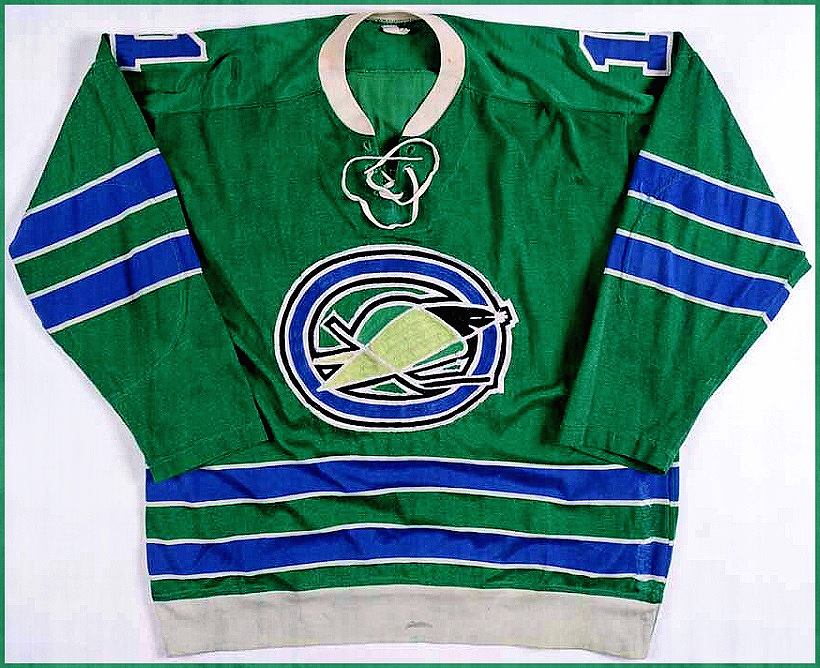
If you are casually acquainted with me, you’ll know that I have long–felt the original home jersey of the Oakland Seals (above) ranks above all others. The blue “O” in the logo was originally a “C”, as the club came into the NHL (as part of the six–team expansion in 1967–68) named the California Seals. When crowds failed to materialize at the Oakland Coliseum–Arena, the “C” was filled in and the team re–named Oakland Seals (in late–November 1967); the objective to attract more local followers. It didn’t work. Though the Seals sported some of the most–iconic uniform designs of the expansion era, they made the playoffs only twice in nine seasons and never won a round (closest call was a seven–game defeat against Los Angeles in the 1969 Stanley Cup quarterfinals). After the 1975–76 schedule, the club re–located in Richfield, Ohio and became the Cleveland Barons. Neither did the team draw in the 20,000–seat Richfield Coliseum (20.7 miles south of downtown Cleveland). After two seasons, the Barons’ roster merged with another of the 1967 expansion clubs, the Minnesota North Stars.
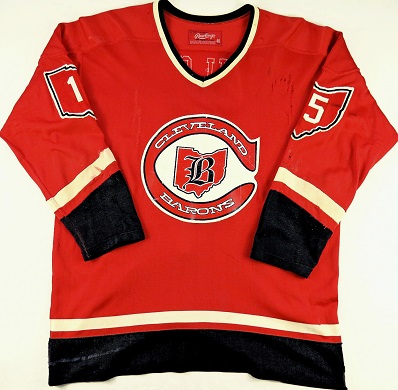
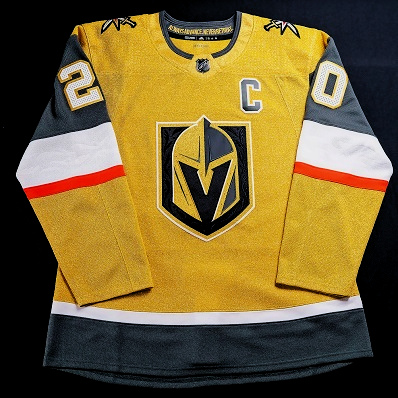
During their two seasons in Ohio, the Cleveland Barons wore the jersey, top–left, on the road. It still ranks among the best designs, with a handsome logo and the sleeve numbers within a map– outline of the state. The best current jersey, in my view, is the alternate (or third) of the Vegas Golden Knights (top–right). The predominantly gold base stands out and perfectly compliments the silver, white and dark–orange trim.
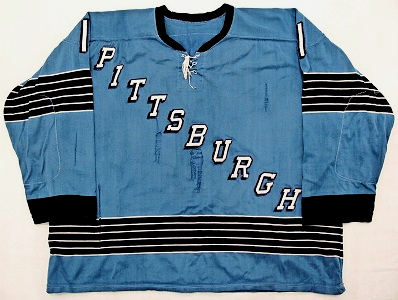
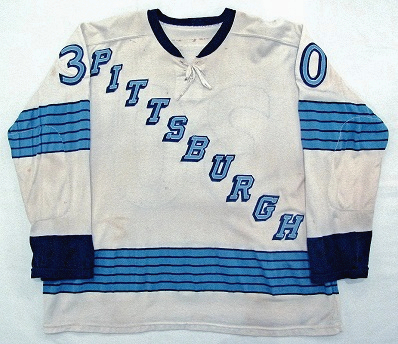
The most ordinary of the expansion jerseys in 1967–68 is still among my favorites. The Pittsburgh Penguins wore the above jerseys (light–blue at home, white on the road) in only their first NHL season. Reason being the club waited too long to compose its initial logo. As such, the city name appeared diagonally across each uniform. In their second season (1968–69), the Penguins altered both jerseys (below) and placed the logo on the front.
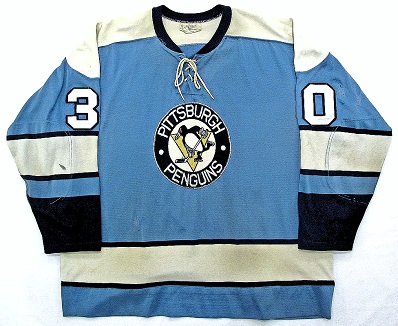
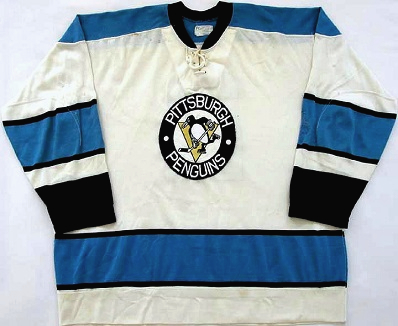
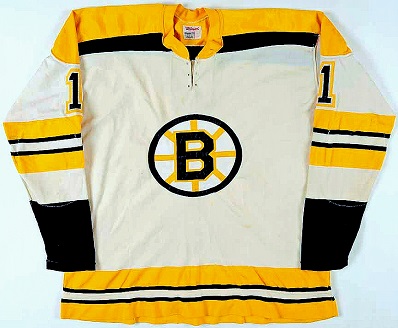
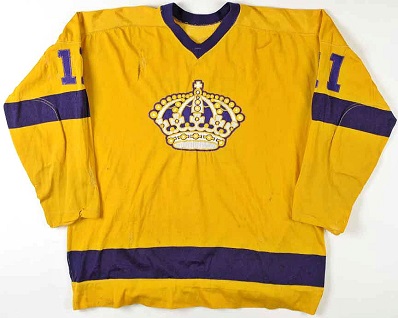
I have always liked the jersey the Boston Bruins wore (top–left) between 1967–68 and 1973–74. The gold piping on the shoulder, oddly removed afterward, blended superbly with the gold–and–black stripe at the bottom of the uniform. This is the jersey worn by Bobby Orr, Phil Esposito and Co. when the Bruins won the Stanley Cup in 1970 and 1972. The original road jersey of the Los Angeles Kings (top–right) in 1967–68 was unique as the only such item not with a predominantly white base. The gold jersey and socks were complimented by purple pants. At home, the entire uniform was purple, with gold trim. This was the first of the ’67 expansion designs to appear at Maple Leaf Gardens. The Kings, with ex–Leaf Terry Sawchuk in goal, lost 4–2 to the Leafs on Oct. 25, 1967.
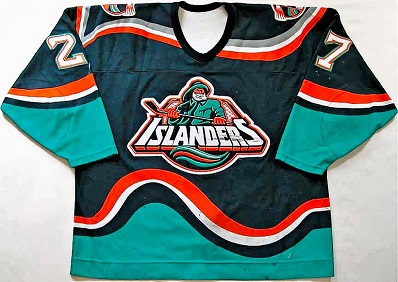
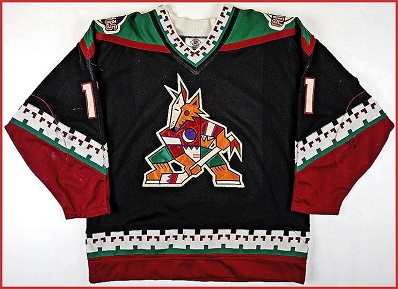
Alright, go ahead and laugh. Everyone else did when the New York Islanders (top–left) departed from their original uniform and trotted out the “fish sticks” jersey (road version, here) for the 1995–96 season. The “High Liner” logo featured a man with a thick beard that resembled long–time New York hockey author Stan Fischler. And, how could you not admire the wavy stripe pattern of the sleeves and jersey. Sadly, this design lingered for only that one season. The club returned its original (and current) logo to the jersey in 1996–97, then went back to its original uniform for 1998–99, though it maintained the navy base–color (instead of royal blue).
I still give high marks to the original road jersey (top–right) of the Phoenix (now Arizona) Coyotes in 1996–97, the season the franchise moved south from Winnipeg. The colors and design were indigenous to the southwest and the logo had to be the product of an acid trip. How else to explain the two–headed desert dog?
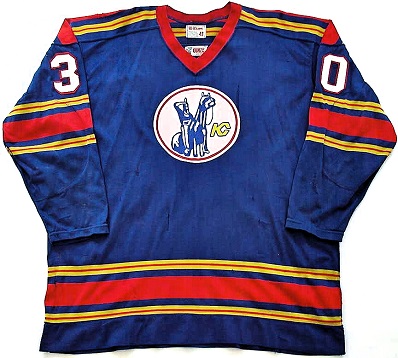
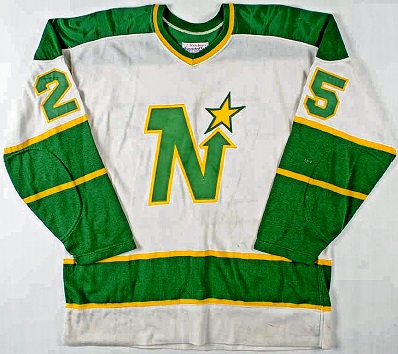
The Kansas City Scouts joined the NHL as an expansion team (with the Washington Capitals) in 1974–75 and wore the jersey, top–left, on the road for two seasons. The blue–gold–red–white color scheme was sharp, even if the logo — an image of the famous “Scout” statue in downtown Kansas City MO — was far–too small for the jersey front. This was among the most–inept teams in NHL history. While playing out of Crosby–Kemper Memorial Arena, the Scouts posted records of 15–54–11 and 12–56–12. The franchise re–located to Denver for the 1976–77 season as the first Colorado Rockies (copied, 16 years later, by Major League Baseball), then moved, again, to East Rutherford NJ in 1982–83 as the New Jersey Devils. Today, the club plays at the Prudential Center in downtown Newark. That horrific Kansas City outfit later won the Stanley Cup three times between 1995 and 2003.
The Minnesota North Stars entered the NHL in 1967–68 wearing the jersey, top–right, on the road. The North Stars and Seals were the first NHL clubs to feature green as a primary color. Minnesota’s “arrow–and–star” logo is among the best in league annals. The club relocated to Dallas in 1993–94 and dropped “North” from its name.
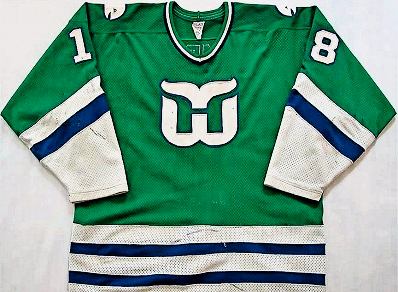
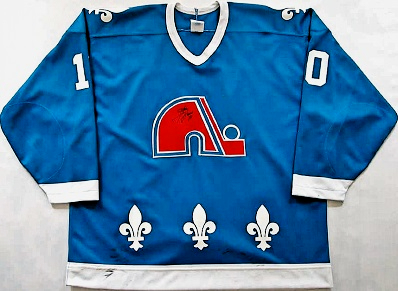
The NHL, in 1979–80, absorbed four teams from the remnants of the World Hockey Association, including the Hartford Whalers (top–left) and Quebec Nordiques (right). Both jerseys quickly became iconic. At one point during the season, Hartford iced an all–time forward unit of Dave Keon, Bobby Hull and Gordie Howe.
Throughout 16 seasons in Quebec City, the Nordiques and Montreal Canadiens fashioned the most–intense rivalry in NHL annals. Quebec relocated in Denver for the 1995–96 season as the Colorado Avalanche. The Whalers moved to Greensboro NC (eventually Raleigh) in 1997–98 as the Carolina Hurricanes.
EMAIL: HOWARDLBERGER@GMAIL.COM

































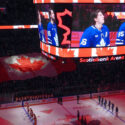


The all-time second greatest sports jersey is the iconic Dallas Cowboys.
However, the cowboy’s jersey pales compared to the all-time greatest sports jersey, which belongs to the NY Americans (Amerks) who were the third expansion team.
I was in the minority, but I also loved the Highliner and Desert Dawgs jerseys. So creative, so unique.
In my defense, I did move 18 million out when I traded Nylander and Marner. But sure, probably not enough for a top goalie, top defenceman and Hyman and the rest of the roster. This flat cap is going to be torture for Leaf fans.
Howard: I have the unique distinction of working radio and tv play by play for not one but 2 failed franchises: the California Golden Seals and the Colorado Rockies! I believe the Rockies colorful home uniform of blue, red and gold with the theme of “ROCKY HOCKEY” deserves to be honored as well.
By the way, it hurt to have to leave the NHL because it was clear the Rockies wouldn’t survive. It worked out ok as I had 22 years and 3 Super Bowls calling games for the San Francisco 49ers.
Best wishes, Joe Starkey
I’d say it worked out! And, yes, the Rockies uniforms were nice. They maintained the Kansas City Scouts’ color scheme. Hope you are well, “bonanza” man.
I haven’t replied to one of these in a while, so I’ll add my thoughts.
If there is a top tier goalie available that can legit save games for a team, I’m interested. I like Campbell, and maybe he is the next Tim Thomas, but I’m not opposed to moving him for an upgrade. I would go hard after MAF if he’s available (doubtful). I can’t think of a more motivated goalie.
Sign Dougie Hamilton already. Just do it. Don’t move Reilly. Keep them both. Modify your offense to come from Defence more often.
Resign Hyman. He’s going to be solid on a cup winning team one day.
In my world, Nylander is out for sure. Nylander is not the kind of player you build around. He’s a passenger, not a driver. I probably (begrudgingly) move Marner too, hopefully for Buffalos first. Sadly, he becomes a cap casualty to rebalance the roster. I hate the lack of offense on my new Leafs, but as they say, build from the net out.
Not sure how you make the numbers work there, but that would intrigue me. As constructed, it’ll be hard to get behind the club again this year.
Sign Dougie Hamilton. Re-sign Hyman. Oy. Please Google “salary cap NHL.”
LOVE the Seals Jersey, always have. It’s unique, nostalgic, historic and brings back memories of when I was a little kid. Of the others, I like the Whalers jersey, love the North Stars jersey. I have a Bobby Orr rookie replica home jersey, which is beautiful. For all the others, sorry not a fan. I enjoyed the Kings’ purple jersey. I think the Avalanche 3rd jersey from last year with the Nordiques reference is stunning, Original Penguins is nice as well, but that’s about it for all the others.
I agree with the goaltender issue. But the real elephant in the room is Mitch Marner’s outrageous salary. Sure he’s a talented player, a great playmaker, during the regular season. But, he’s small and, like most of the teammates, not physical enough for the playoffs. We’ve seen that two years in a row. Unloading Marner and eating let’s say 50% of his salary could free up the money for the Leafs to acquire two skilled, gritty players. Otherwise, I can’t see them going beyond the first round for many years to come.
“Complemented”
Howard.
My first game as a linesman in the NHL was in Pittsburgh in 1972. The California Golden Seals were the visiting team. Brings back some good memories.
Bob Hodges